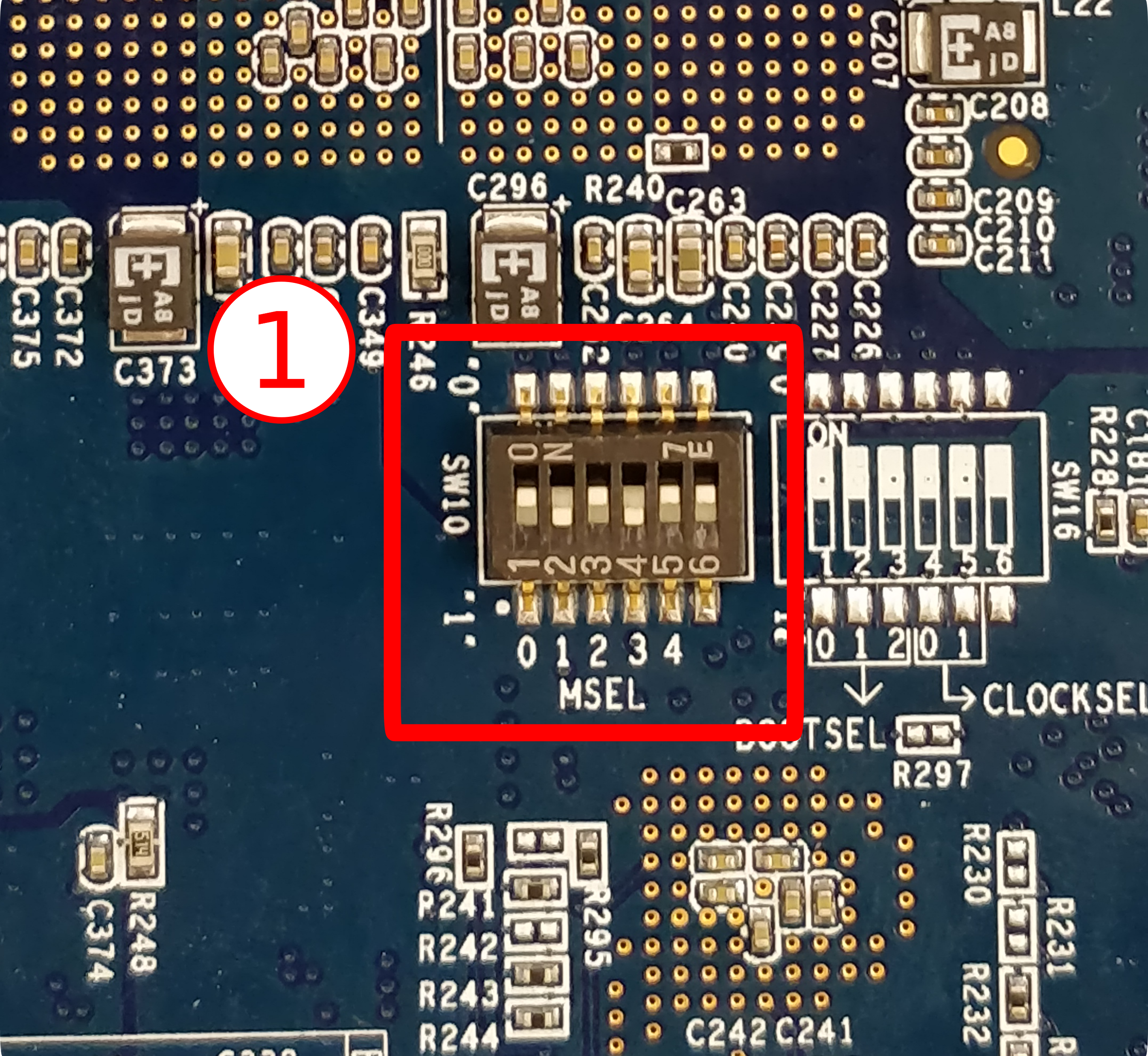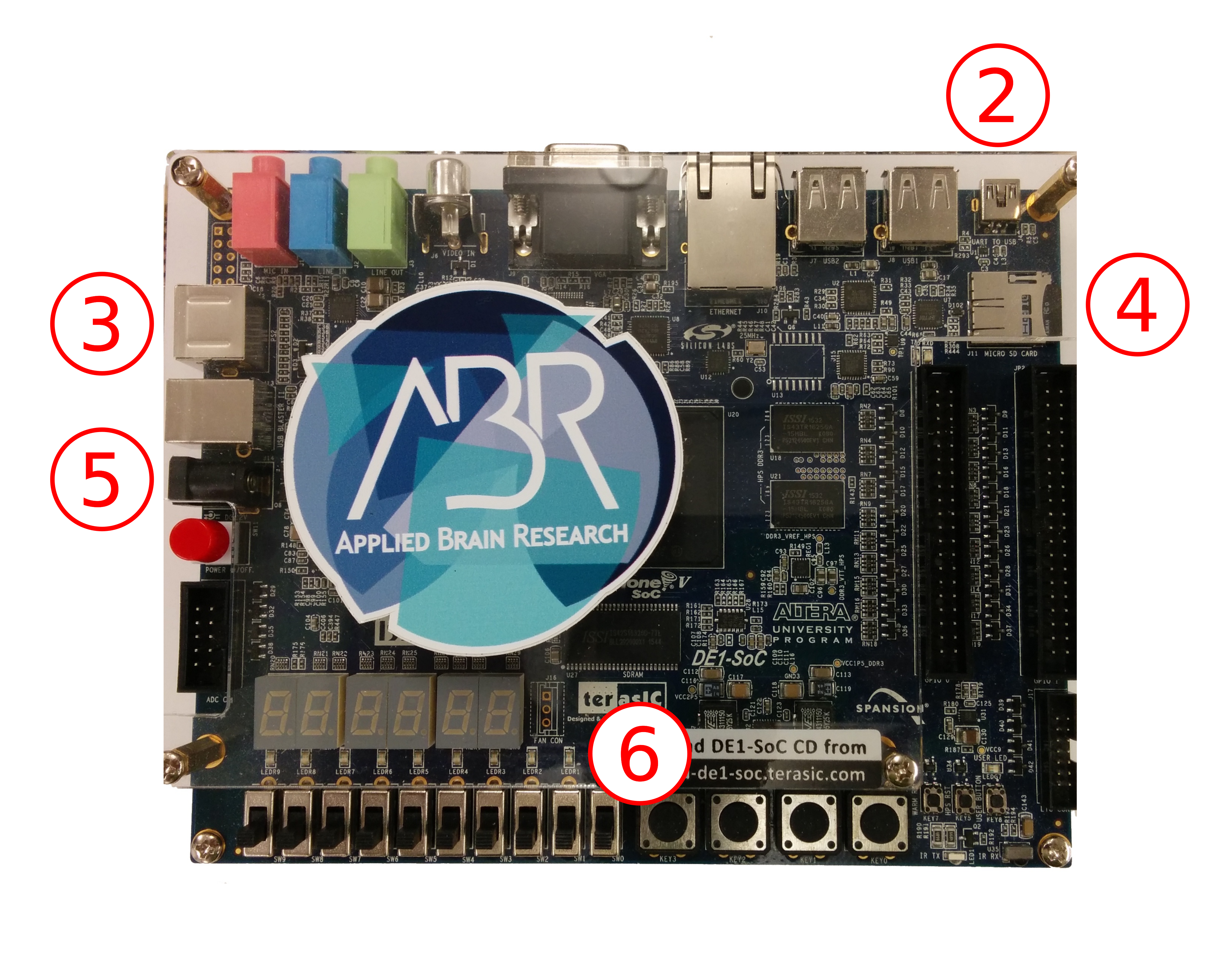Getting Started¶
Things You Need¶
Some things you will definitely need:
- DE1-SoC kit
DE1-SoC board
USB to Mini-USB (for UART)
Power supply
MicroSD card at least 4GB in size
MicroSD card reader for your computer (if SD card is not pre configured)
Ethernet cable
A sense of wonder and excitement
Warning
The documentation assumes you have a microSD card configured from Applied Brain Research. If you are setting up your own board please see the Creating the SD Card section.
Installation Quick Reference Guides¶
Setting up the board can involve multiple steps depending on your computer and network configurations, so here are some quick reference guides. Use the middle-mouse-button click or press CTRL+left-mouse-button click to bring up each link in a new browser window.
Getting the Board NengoFPGA Ready¶
This guide details how to set up the board and your computer to be ready for use with NengoFPGA using a direct Ethernet connection between your computer and the board. If you only have one Ethernet port on your computer, it is recommended to use a USB-to-Ethernet adapter, or to follow this guide.
Setting up the board using this guide does not allow you to:
Have internet connectivity on the board.
Installation steps:
(Optional) If you don’t have one already, create the microSD card with the NengoBrainBoard image.
Connect the board to your computer with a direct Ethernet connection.
Configure the SSH between the board and your computer. Note that you will need to assign your computer a static IP address.
(Optional) If you haven’t already, use NengoFPGA to obtain your Device ID.
Copy the NengoFPGA bitstreams to the appropriate location.
Your system should now be NengoFPGA ready.
Getting the Board NengoFPGA and Internet Ready¶
This guide details how to set up the board and your computer to be ready for use with NengoFPGA, as well as providing internet accessibility to the board. It is recommended to use this guide if you wish to connect multiple boards to the same network your computer is on. It should be noted that getting internet access on the board is not necessary for NengoFPGA functionality. Rather, having internet access on the board is a convenience for your own development processes.
Installation steps:
(Optional) If you don’t have one already, create the microSD card with the NengoBrainBoard image.
Connect the board to your Ethernet network setup.
Configure the board to connect to the internet
Configure the SSH between the board and your computer.
(Optional) If you haven’t already, use NengoFPGA to obtain your Device ID.
Copy the NengoFPGA bitstreams to the appropriate location.
Your system should now be NengoFPGA ready, and should be connected to the internet.
Caution
If you have more than one board connected to your network (this is only possible using a network switch or router), make sure that each board has a unique IP on the network.
Caution
If you have more than one board connected to your network (this is only possible using a network switch or router), and you are using the NengoBrainBoard SD image, you will need to ensure each board has a different MAC address. See Changing the Board MAC Address for how to do this.
Only Getting the Device ID¶
This guide details how to set up the board and you computer to obtain the board’s Device ID only. Use this guide only if you are short on time and do not yet need to have the full NengoFPGA functionality available on your system. If you wish to have full NengoFPGA functionality available, it is recommended you follow the other guides in this section.
Setting up the board using this guide does not allow you to:
Use NengoFPGA with board.
Connect the board via SSH.
Have internet connectivity on the board.
Installation steps:
(Optional) If you don’t have one already, create the microSD card with the NengoBrainBoard image.
Connect your computer to the board via UART
Go to
/opt/nengo-de1/and run the command:python ./nengo_de1/id_script.py
Other Board Configurations¶
If your system setup does not match any of the guides detailed above, please contact us for instructions tailored to your system.
Setup the DE1-SoC Board¶
If you purchased a board through Applied Brain Research the board should already be configured as seen in step 1 and the SD card should be ready to boot with all requirements loaded and installed. If you have your own board ensure it is configured as below and the SD card has the appropriate image loaded.
Before plugging anything in, make sure that the board is configured properly. Look at the bottom of the DE1-SoC board, you should see a bank of small dip switches labeled “MSEL”. Make sure the switches are set to MSEL[5:0] = 001010, as shown in the image above.
Connect the board to your computer using the USB cable. The Mini-USB end will connect to a port labelled “UART TO USB” near the microSD card slot.
Connect the Ethernet cable from the board to your computer, router, or switch.
Insert the microSD card into the card slot also near the USB ports. The SD card should be shipped with the correct image flashed but if you are setting up a board not purchased through us or you are updating the SD card image then see the Creating the SD Card section for more information.
Connect the power supply to the board via the barrel plug near the red power button and press the red power button to boot the board.
If the board has booted correctly you should see 4 red LEDs counting up in binary.

